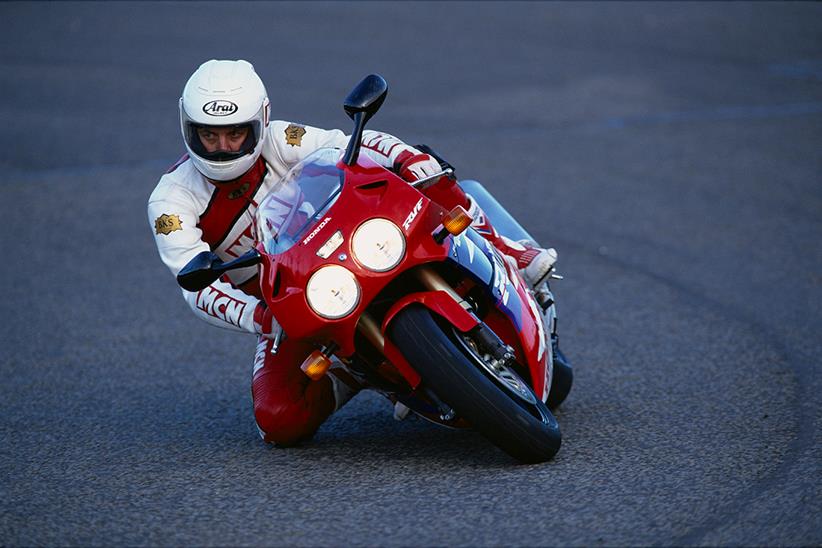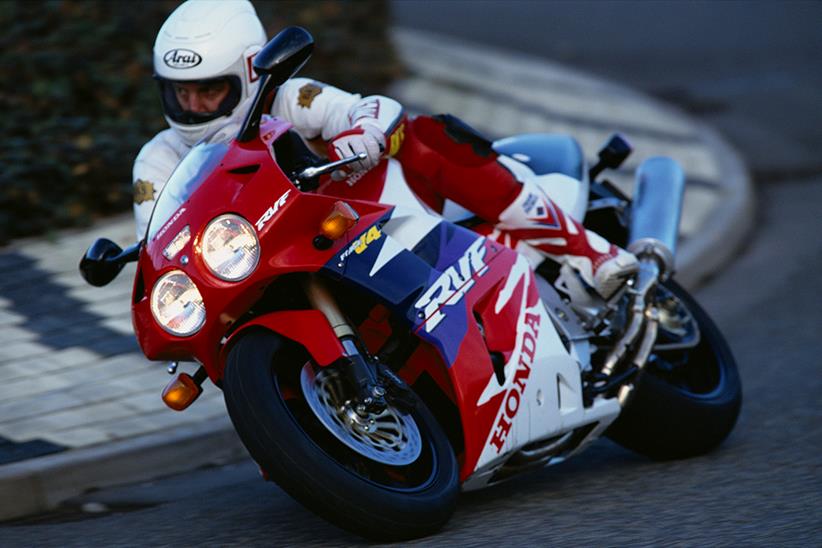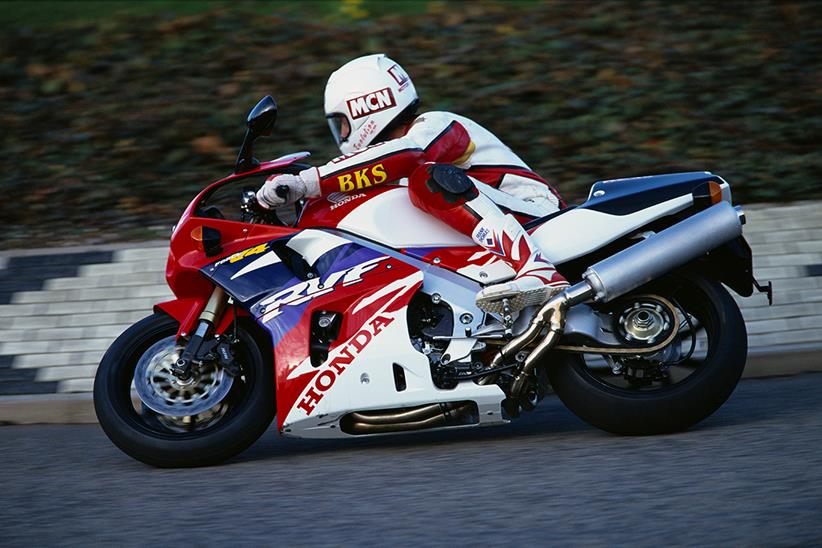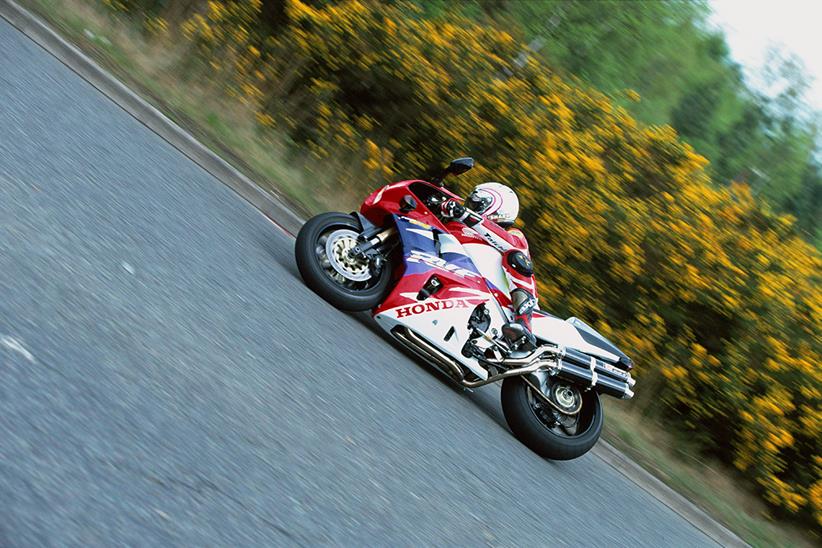Our first ever ride of the Honda RC45
23 years ago today we published our thoughts after riding the Honda RC45.
Here's what we thought of the bike when we got the chance to pit it against its equally legendary brother, the Honda RC30 back in 1994.
If looks could kill, the RC45 would probably give you a mild headache. The styling of Honda’s racer-on-the-road is well balanced and even aggressive if you’re the nervous sort, but it hardly looks like an £18,000 motorcycle.
Ride it though and its a completely different story. The whole feel of the machine is of a racing bike, and a top-notch one at that. The riding position is undoubtedly track orientated, though RC30 riders will appreciate the extra room the newer bike provides. The original V4 racer perches the rider on top and right over the front wheel and, though the 45 does the same, it’s in a less-radical manner.
TOP STORIES
- Video: Motorcyclist jumps over open motorway
- New 125cc bikes for 2017
- Our top 5 biking hoodies
- Join the party at the Festival of Motorcycling
- RiDE review: Dainese Carvemaster
The RVF750 (as Honda’s race department didn’t want the road version of the RC45 called) is larger and broader than the tiny RC30, but this is deceptive. Move it around even at a standstill and the money spent on reducing the RVF’s weight shows its influence, despite being taller, the newer machine carries its weight lower, and feels and feels altogether more wieldy.
Fire it up and the relationship between 30 and 45 is obvious, even if the RVF’s motor is entirely new. Honda’s V4 engines sing a distinctive flat baritone that racegoers the world over have grown to know and love over the years.
The spectator catches the exhaust note, but the rider sits on top of the intake, and it’s this snarl from beneath the tank which is so irresistible. As the RVF’s revs build, which they do with real force from 4000rpm up to and beyond the 12,500rpm red line (with the limiter doing its job 1000 revs later), the gulping 46mm injector bores hit a mid-range resonance which almost stirs the blood as much as a Ducati’s lop-sided beat. Not quite, but almost…
![]()
But first the mechanically-sensitive will warm the motor up which, as you’d expect of a 1994 Honda, involves nothing more than a push of the starter switch. The choke knob mounted on the left fairing inner is actually nothing more than a fast idle lever, as the extra richness a cold motor demands is catered for by the Programmed Fuel Injection system (PGM-FI) lifted from Honda’s technology showcase, the NR750.
This is fed information from seven sensors measuring critical parameters such as intake air temperature, barometric pressure, rpm and so on, and then supplies the right quantity of fuel ignited by a spark at the optimum moment.
The microchip controlling this is replaceable, meaning carburation and power characteristics can be altered in seconds to suit different tracks and conditions, but this is something the road rider won’t need to worry about.
Not unless the off-idle stutter can be cured, that is. This is a racer on the street, so we shouldn’t be too critical, but it’s still irritating when the engine stalls (repeatedly) if you try to pull away gently.
It’s overcome by the simple expedient of using more revs before letting out the clutch, but it’s a sign that the new technology still has something to learn from the good, old-fashioned 35mm Keihin CV carbs of the RC30.
Get rolling with the digital temperature indicator to the right of the central tacho showing 70ºC or more (85ºC if you’re really considerate) and you’ll forget all about riding gently.
The power supply is almost endless, and though the motor pulls hardest from 9000rpm it’ll do useful work from less than half that. But keep it spinning and the acceleration is almost violent. The RVF won’t quite match a FireBlade for sheer thrust, but keep reminding yourself, it’s only a 750. Against a YZF performance is similar, but in real life the Honda will charge ahead because of its superior mid range. The RC30 will be consigned to the mirrors too.
The older bike being capable of only matching, not beating the latest crop of three-quarter-litre hotshots in a straight line. Not bad for a six-year-old bike though…
The RC30’s age is felt through the bars too, as a raw, harsh vibration which is at its worst at around 8000rpm. The RVF hints at the same, but though it can be buzzy, it’s never as uncivilised as the RC30 in this respect.
Chassis have moved on too, at least as much as the motors. In a straight line the RVF feels as stable as the RC30 – neither crosswinds nor ridges along the road bother it despite the monstrous 190 section rear rubber. But flick the bike down into a turn and the older bike feels like a lorry in comparison.
The RC30 swings down into the turn and gets round it with speed and security. The RC45 dives on to its side then turns so fast it takes your breath away.
Wall-of-death riders and anyone who’s ridden round a test circuit’s steeply banked turns know the sensation of a bike thrusting up hard beneath them. RC45 owners can experience that too, as the bike changes direction so dramatically you can feel the g-force squashing you down on to the tank.
Honda has spent the last few years centralising the mass of its bikes to reduce the moment of inertia and resistance to turning. And it’s reached a peak with the RC45, which goes round like a spinning skater with his arms drawn in, compared to the hands-flung-wide slow rotation of the RC30.
Ground clearance is the limiting factor, the long hero blobs on the footrest scraping before the tyres run out of tread, but this doesn’t unsettle the machine. Indelicate throttle control does though. Several grand prix riders have complained that the fuel-injected versions of their 500cc Hondas have needed ultra-sensitive treatment of the twistgrip, and the RVF displays the same trait. Trying to feather the throttle for a constant supply of power round a long bend often results in an on-off action which easily throws you off line.
![]()
The RVF changes line at the first hint of pressure from the rider, whether through the bars, footrests, or a knee against the tank, and for this reason smoothness has to be learnt all over again. Once you’ve mastered it, it’s a delight. You feel right on top of a front wheel which does your bidding down to the last fraction of a millimetre. The low, steeply-angled bars which are so uncomfortable at low town speeds (because of their angle as much as position, like a FireBlade’s) suddenly start to make sense, offering maximum control and rewarding skilled input.
It’s the 16-inch front wheel that’s at the heart of the sensitivity, a dimension only Honda is sticking with. It certainly works, but the rider has to work too.
If you’re not sure of your line or the road surface (or if you’re a poor rider…) the RVF will be petulant, lurching on and off the throttle and twitching across the road in response to ham-fistedness. It’s very much a rider’s bike, magnifying ability or lack of it without favour.
The tyres and suspension will probably save you if you’re struggling. Grip from the new Dunlop Sportmax IIs is far superior to earlier Sportmaxes, and importantly feedback is good. That monstrous rear rubber digs in hard under power from a turn, letting you nail the throttle with even more lean dialled in than Jack Sprat.
Do this on a rougher surface and the wheel tracks the road surface with uncanny precision, driving the bike forward when lesser machines would be kicking out the tyre.
The front is equally impressive, offering enormous grip and sensitivity even under the immense braking forces available from the four-piston calipers. These have less sheer power than some more fashionable six-pot set-ups, but many riders are finding those a bit too much for road use. In terms of usability the RC45’s are supreme.
Like all the best set-ups, the RC45 doesn’t just supply superb cornering control, but excellent ride quality with it. It’s not as firm as you might expect, yet never chops or wallows whatever you do, instead maintaining wheel control and composure on a variety of surfaces never encountered on the track.
Verdict
There’s no question about the RVF’s ability. It’s a superb racer for the streets with as much ability as any road rider could want. It makes the RC30 feel like a bike from another era, albeit a fairly recent one.
Instead, the RVF’s problems are its price and its looks. For the same money you can park a super-sexy SB6 Bimota in your drive, plus a pair of wheels to commute on. Or get yourself a Ducati 916, a BMW F650 and cruise the Med this summer. All for the price of a bike that looks like just another Japanese race replica.
We currently have four much sought after RC45s for sale at MCNbikesforsale.com, pictured below. If you’re interested you’ll have to act fast, they don’t hang around for long.
Looking for the perfect two-wheeled companion? Visit MCN Bikes For Sale website or use MCN’s Bikes For Sale App.










